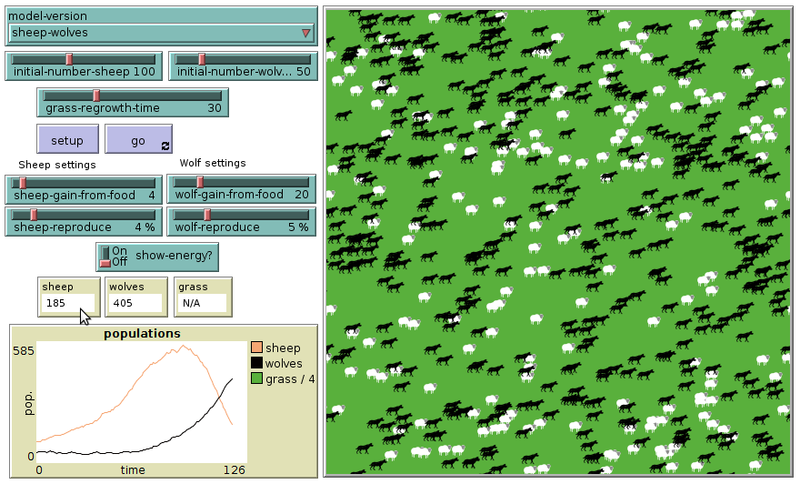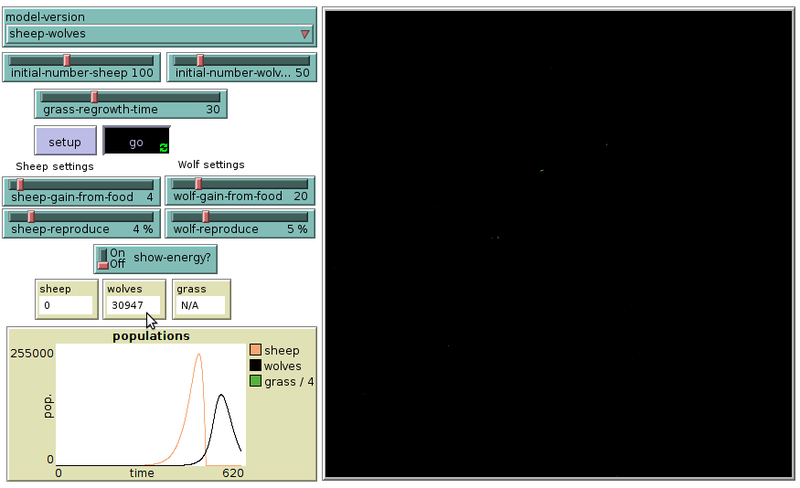NetLogo Wolf Sheep Predation model: Difference between revisions
| Line 9: | Line 9: | ||
== The Netlogo libray wolf-sheep models == | == The Netlogo libray wolf-sheep models == | ||
The [http://ccl.northwestern.edu/netlogo/models/WolfSheepPredation Wolf Sheep predation model] distributed with NetLogo includes two variants: | The [http://ccl.northwestern.edu/netlogo/models/WolfSheepPredation Wolf Sheep predation model] <ref name="wilensky1997">Wilensky, U. (1997). NetLogo Wolf Sheep Predation model. http://ccl.northwestern.edu/netlogo/models/WolfSheepPredation. Center for Connected Learning and Computer-Based Modeling, Northwestern University, Evanston, IL. </ref> distributed with NetLogo includes two variants: | ||
* A Wolf-sheep model where the wolves (or the sheep) die out | * A Wolf-sheep model where the wolves (or the sheep) die out | ||
* A Wolf-sheep-grass model that is oscillating stably over time | * A Wolf-sheep-grass model that is oscillating stably over time | ||
Revision as of 15:48, 14 March 2019
Introduction
This short article summarized some technical and conceptual hightlights from Wilensky et al. Wolf Sheep Grass predation models created in NetLogo.[1]
NetLogo is a tool for agent-based modelling and simulation, which is part of what can be called computational thinking. Wilensky and Reisman [2] [3] make an interesting case for learning biology through constructing and testing such computational models.
The agent-based version is also discussed in Population dynamics between preys and predators by Moira Zellner and Pierre Bommel and they also present an oscillating version where the wolf/sheep proportion is lower.
The Netlogo libray wolf-sheep models
The Wolf Sheep predation model [4] distributed with NetLogo includes two variants:
- A Wolf-sheep model where the wolves (or the sheep) die out
- A Wolf-sheep-grass model that is oscillating stably over time
The model can be found in NetLogo desktop software like this:
- Open: File -> Models library (CTRL-M)
- Then: Sample Models -> Biology -> Wolf Sheep Predation
You can try running this simulation directly in your web browser. It worked well enough in Firefox/Ubuntu 10 and Firefox/Win10. Both machines did have a good graphics cards. The online version also allows editing the code, i.e. make changes to the inner workings of the model.
A simple wolf - sheep model
Example run: Toward a desaster.
Wilensky [4] defines the first variant like this: “wolves and sheep wander randomly around the landscape, while the wolves look for sheep to prey on. Each step costs the wolves energy, and they must eat sheep in order to replenish their energy - when they run out of energy they die. To allow the population to continue, each wolf or sheep has a fixed probability of reproducing at each time step. In this variation, we model the grass as "infinite" so that sheep always have enough to eat, and we don't explicitly model the eating or growing of grass. As such, sheep don't either gain or lose energy by eating or moving. This variation produces interesting population dynamics, but is ultimately unstable. This variation of the model is particularly well-suited to interacting species in a rich nutrient environment, such as two strains of bacteria in a petri dish (Gause, 1934).”
We ran the model with the default parameters. A model without grass is unstable over time. Since it includes probablistic functions (i.e. the wandering around), the same model using the same parameters can evolve bit differently over time. After a few hundred ticks the world is usually in a bad state and also will take a lot of CPU. E.g. in one run I had 180K sheep, 3600 wolves and no grass after 450 ticks. The wolves then grew > 100K and eat all the sheep. After 775 ticks, only grass was left.



The wolf - sheep - grass model
The second models is described by Wilensky [4] like this: “The behavior of the wolves is identical to the first variation, however this time the sheep must eat grass in order to maintain their energy - when they run out of energy they die. Once grass is eaten it will only regrow after a fixed amount of time. This variation is more complex than the first, but it is generally stable. It is a closer match to the classic Lotka Volterra population oscillation models. The classic LV models though assume the populations can take on real values, but in small populations these models underestimate extinctions and agent-based models such as the ones here, provide more realistic results. (See Wilensky & Rand, 2015; hapter 4). The construction of this model is described in two papers by Wilensky & Reisman (1998; 2006) [2] [3]”
In the picture below you can see that this model has a "stable" oscillation over time. After 4500 ticks, both sheep and wolves are still around.

Bibliography
- ↑ Wilensky, U. (1997). NetLogo Wolf Sheep Predation model. http://ccl.northwestern.edu/netlogo/models/WolfSheepPredation. Center for Connected Learning and Computer-Based Modeling, Northwestern University, Evanston, IL.
- ↑ 2.0 2.1 Wilensky, U. & Reisman, K. (1998). Connected Science: Learning Biology through Constructing and Testing Computational Theories – an Embodied Modeling Approach. International Journal of Complex Systems, M. 234, pp. 1 - 12.
- ↑ 3.0 3.1 Wilensky, U. & Reisman, K. (2006). Thinking like a Wolf, a Sheep or a Firefly: Learning Biology through Constructing and Testing Computational Theories – an Embodied Modeling Approach. Cognition & Instruction, 24(2), pp. 171-209. http://ccl.northwestern.edu/papers/wolfsheep.pdf
- ↑ 4.0 4.1 4.2 Wilensky, U. (1997). NetLogo Wolf Sheep Predation model. http://ccl.northwestern.edu/netlogo/models/WolfSheepPredation. Center for Connected Learning and Computer-Based Modeling, Northwestern University, Evanston, IL.